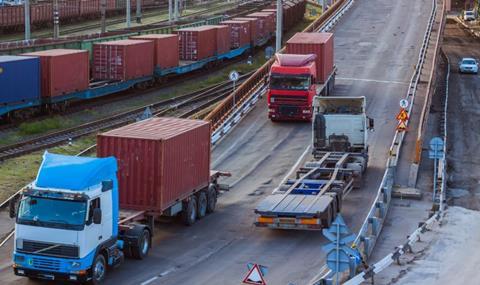
Visitors to the virtual Commercial Motor Show at the end of September may have sat in on the break-out session on eco trucks, when Andrew Malcolm, chief executive of the Malcolm Group discussed a proposed trial of 48-tonne GCW trucks to feed railheads for intermodal operations.
Malcolm operates trains on regular routes running from one of six multimodal terminals in Scotland. Using skeletal trailers and containers, or swap bodies, Malcolm is able to considerably reduce the number of road movements south by using rail to take loads to the Daventry International Freight Terminal (DIRFT).
Using the rail journeys from Grangemouth in Scotland to DIRFT, Malcolm reckons that with a train taking a typical load of 28 containers and maximum of 36, it can save between 19,000 and nearly 25,000 road miles with each train round trip. Malcolm’s proposal has been named, “48 Tonnes for 48 Miles”, because it is designed to use specific designated routes to the railhead using trunk roads over relatively short distances.
Why 48-tonnes? This is driven by the difference in weight between a typical trailer and container/swapbody combination used for intermodal operations (approximately 10.8 tonnes) compared with a curtainsider used for general haulage (approximately 7.0 tonnes), which gives a 44-tonne GCW curtainsider combination a payload advantage of around 3.8-tonnes. The move would compensate for the extra weight of the container/swapbody combination and encourage more freight movements by rail.
The Malcolm proposal came on the DfT’s radar and plays a significant part in the DfT’s consultation for a similar trial. The consultation opened on 9 November and will close on 4 January 2021. Details are listed below and DfT is inviting both responses as well as applications to take part in a trial, should one proceed.
Both the DfT and David Turner, the rail director at Malcolm Logistics point out that the trial is not intended to be a back door route to extending 48-tonnes GCW operations to general haulage. There is a good reason for that as the consultation document highlights, “If this trial goes ahead, it would not be allowing the use of 48-tonne maximum laden weights for all intermodal journeys in Great Britain because most bridges and structures are not designed to accommodate these loadings.”
Read more
- DfT mulls trial of 25.25m long, 60-tonne road train
- Operators could be allowed longer semi-trailers after successful trial
- Road trains could offer eco-friendly solution to shifting freight
An extensive and costly programme of reinforcement would be necessary even to permit trials over all possible routes to intermodal terminals, let alone any possible extension to general haulage.
The central features of the proposal are that any trial would be limited to specific routes, would be likely to be limited to a maximum journey length which is proposed to be 50 miles, while movements would have to be part of a domestic intermodal (road and rail) operation.
DfT’s preliminary technical assessments shows that there may be public benefits if these operations were to help rail freight gain a larger market share than it might otherwise have. In addition, where the road routes do not result in specific extra costs for relatively weak infrastructure, the quantified public benefits could outweigh the costs and disadvantages. DfT sees a trial as the way to gather the information needed to assess the costs and benefits and other considerations. The Department also concedes that secondary legislation is likely to be needed to allow the trial to take place.
This is probably because of the current limitations of permitted axle loadings and outer axle spread. Malcolm logistics acknowledges that operation up to 46.25 tonnes GCW is possible within existing designs, but that to go to 48-tonnes GCW will require changes.
“To get to 26-tonnes on a tractor, you need an outer axle spread of 4.3m," product manager at Volvo Trucks John Comer told motortransport.co.uk. This would favour tag axle designs rather than pushers and as Comer points out, the market for tag axle designs is quite small. Other concerns include the use of 10.5-tonne drive axles, which might have a serious impact on traction, perhaps favouring double drive.
David Turner at Malcolm Group told us, “It’s about an opportunity to grow intermodal freight by balancing the capabilities of road and rail and taking the journeys off motorways and trunk roads.”
Links: DfT Heavier Intermodal Freight Trial: https://www.gov.uk/government/consultations/heavier-intermodal-freight-trial. Full details of the consultation and how to respond.














